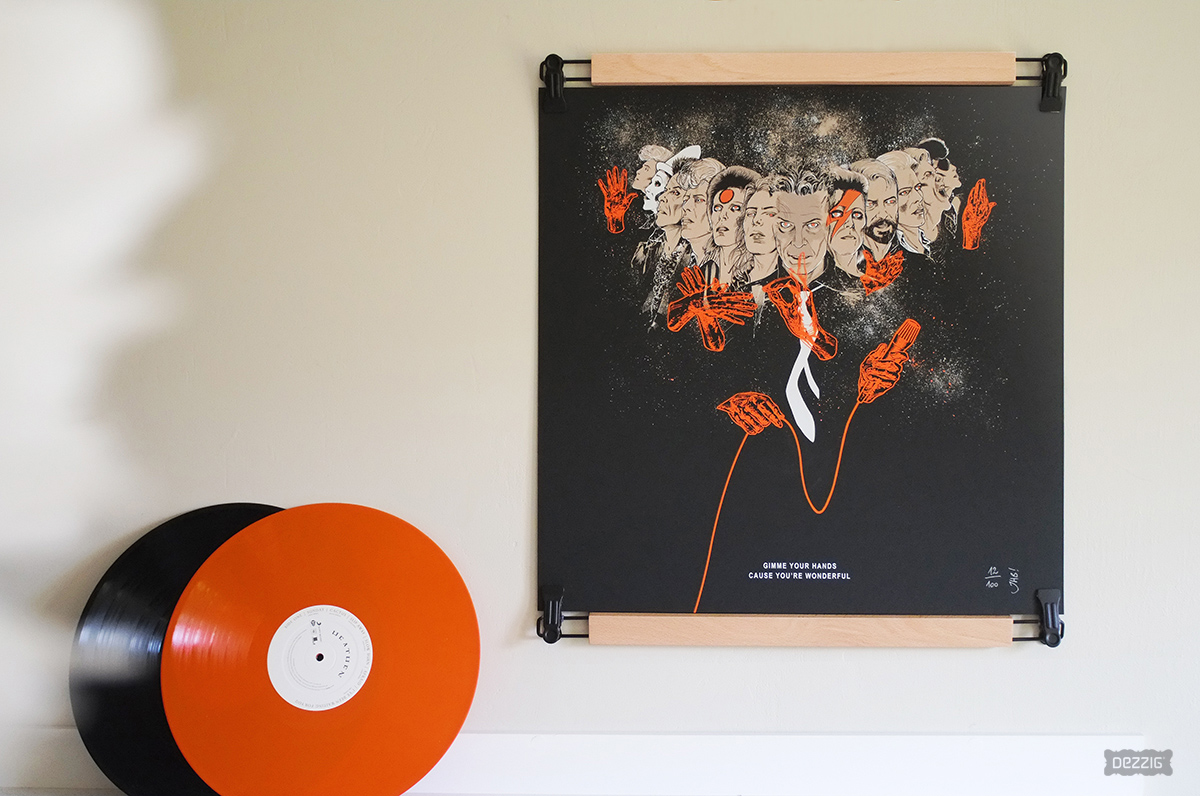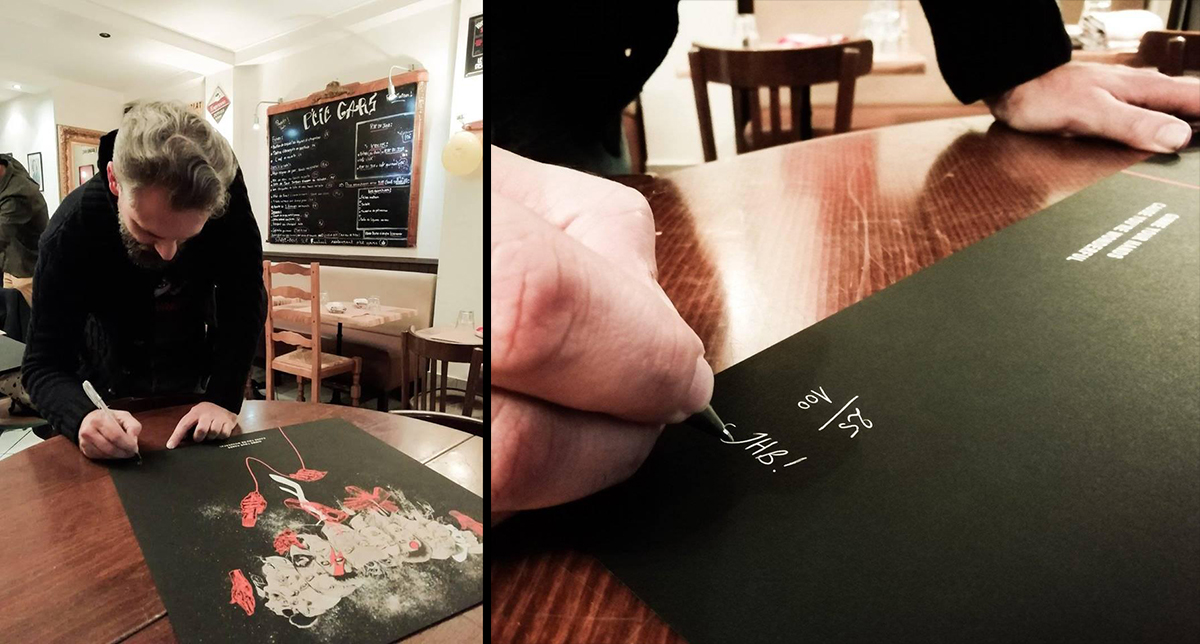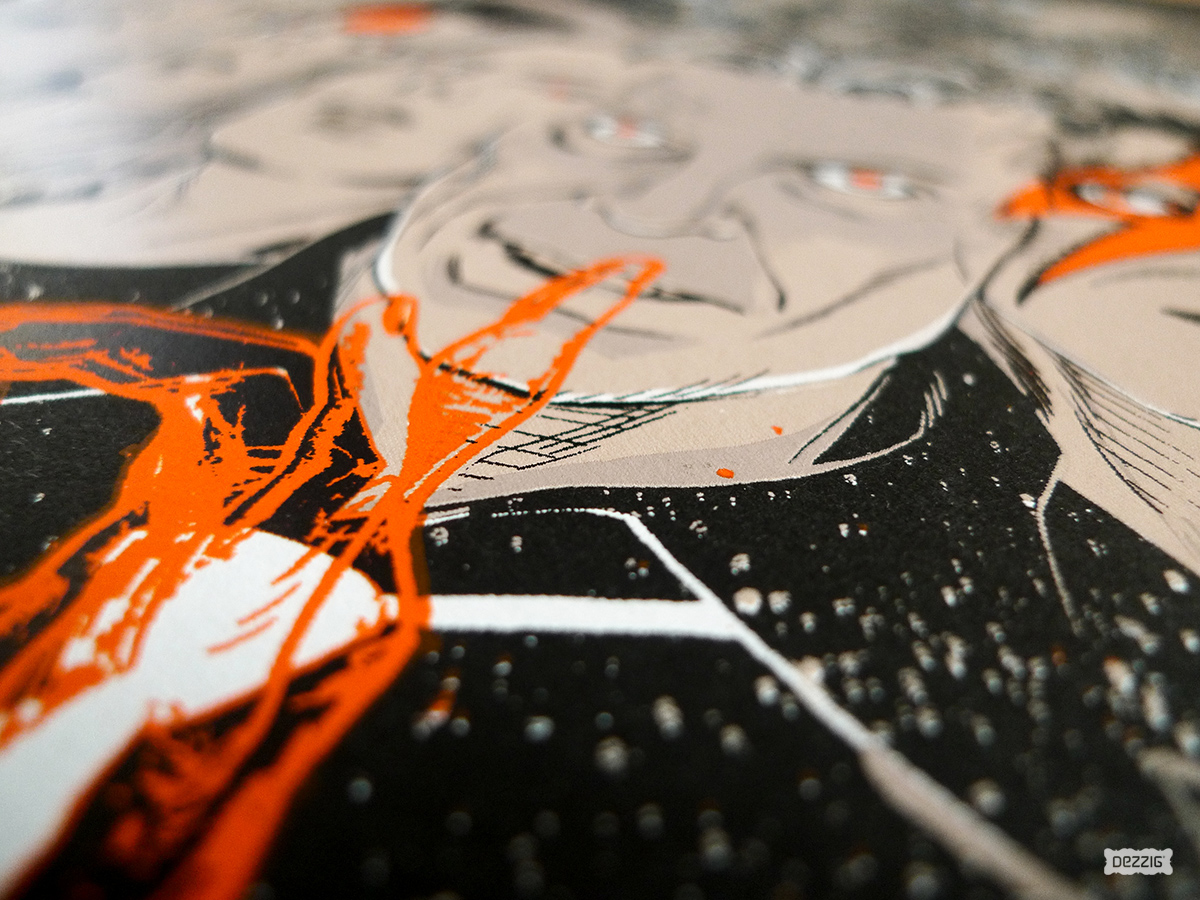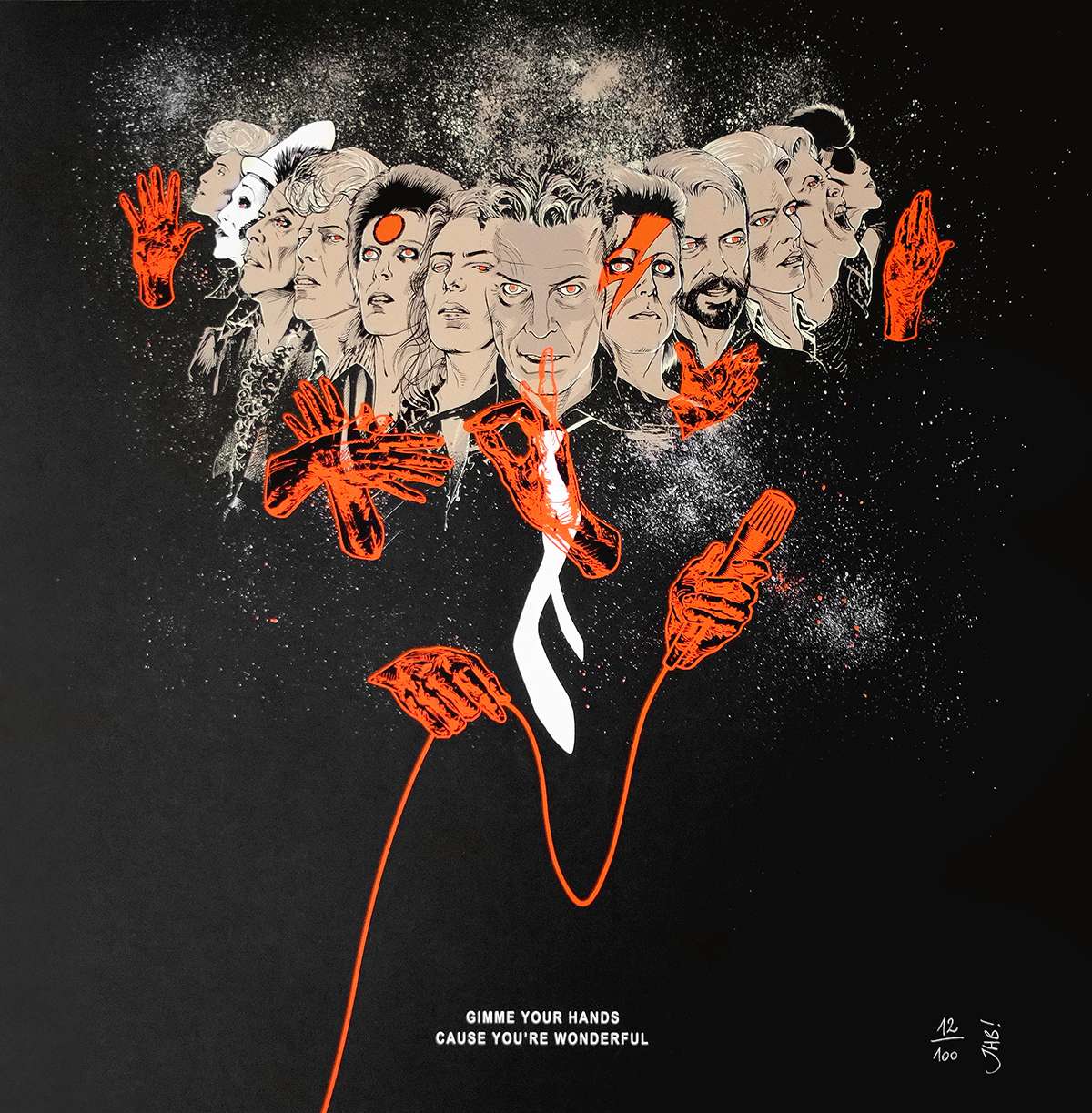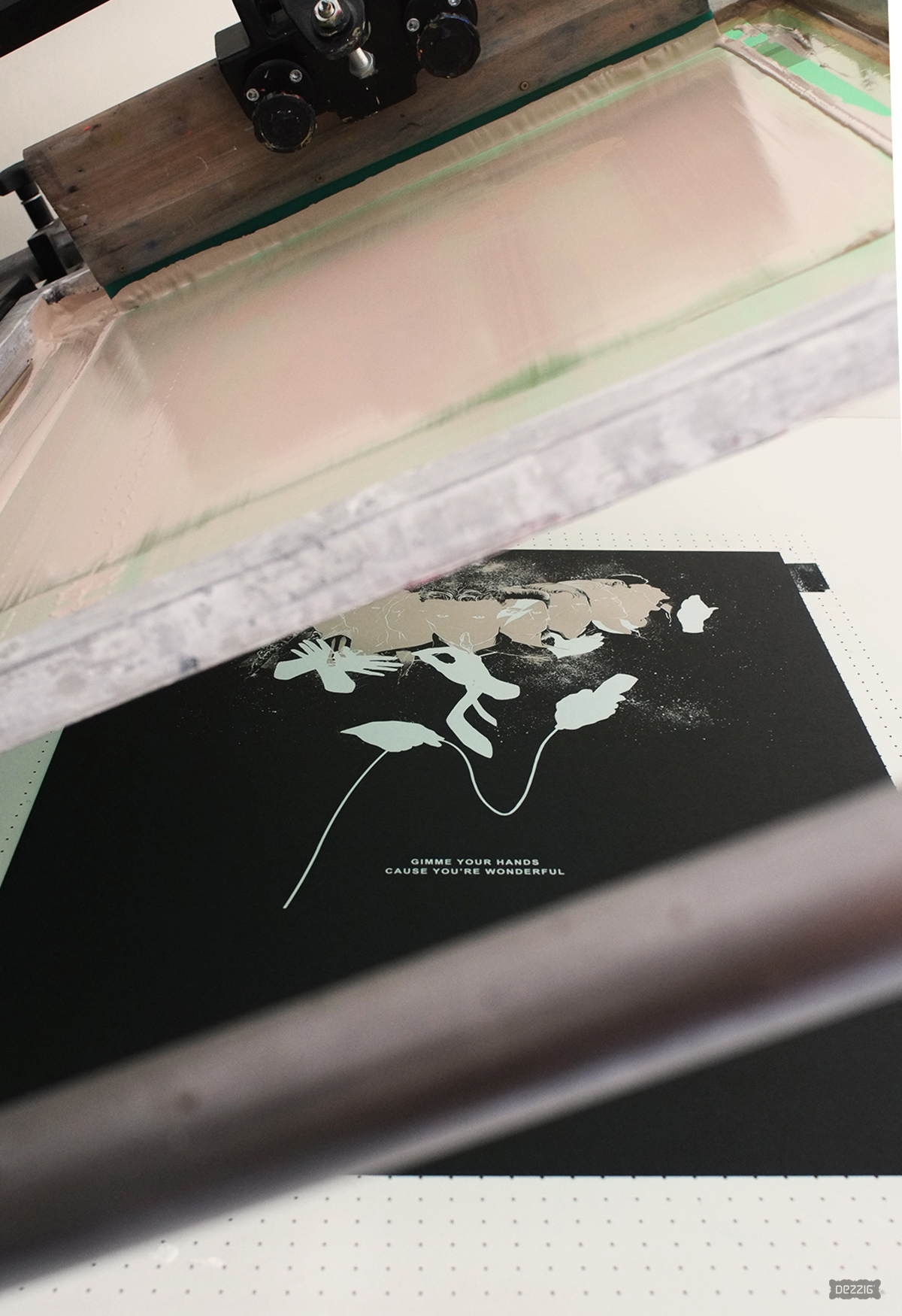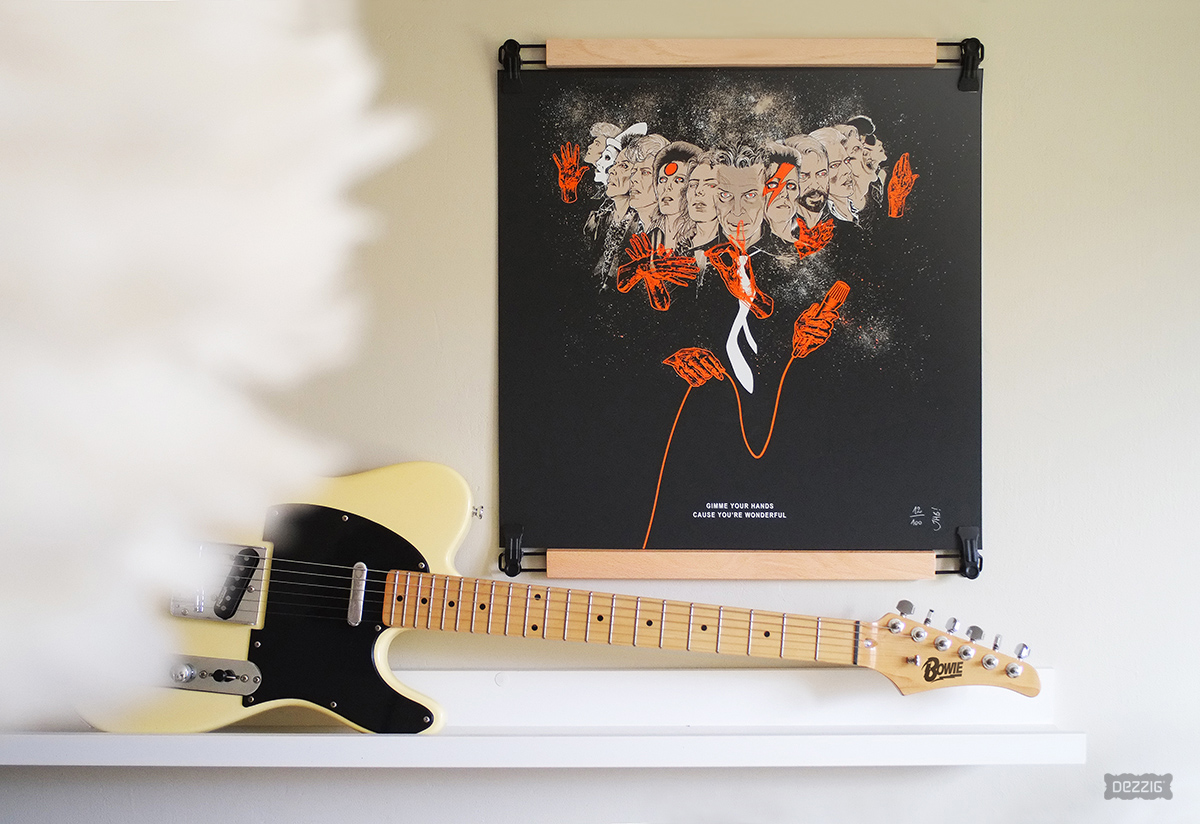Bowie was always a master of disguise, slipping through the cracks with makeup, costumes, and androgynous looks. He had it all figured out! Inspired by Andy Warhol, he learned to play the role—to become someone else in order to stay ahead of the game. With a lightning bolt streaked across his face and a blaze of orange hair, Ziggy Stardust was a rock ‘n’ roll alien. This David Bowie screenprint, published by Dezzig and designed by Julien Hugonnard-Bert, captures Bowie’s spirit—the ultimate chameleon of pop.
It took twelve faces to represent Bowie’s career! This Bowie screenprint poster, printed at the Dezzig workshop in 5 colors (including neon orange ink) on 260 g Fedrigoni Sirio Black paper (50 x 50 cm), is available in a limited edition of 100 copies at the artshop.
It’s also a beautiful collaboration with Julien Hugonnard-Bert, a comic book illustrator based in Rouen. He now works for both American and French publishers such as DC Comics (Injustice: Year Two), Dark Horse (Star Wars), Avatar Press (Crossed), Marvel, Delcourt, and Soleil. Julien is one of the few French inkers to make a name for himself in the world of comics. And as a true fan of music and rock posters, it was in that spirit that he shared his Bowie screenprint poster project with me.
“I’ve always been a strong advocate for editorial illustration. I firmly believe in the superiority of drawing over photography when it comes to portraying someone and illustrating an article. And David Bowie was my go-to example. A photo of Bowie at any given moment only brushes the surface of his vast career and many personas. Only a drawing or painting can truly represent Ziggy Stardust, the Thin White Duke, and the singer of Let’s Dance. The Anglo-Saxon press has understood this well, and for decades, Playboy has entrusted its illustrations for articles and interviews to painters. I wanted to pay tribute to him in the purest Anglo-Saxon tradition by focusing on two main aspects: his many transformations, yes, but also his eyes and hands. Paradoxically, David Bowie trained as a mime and often highlighted his hands. Just look at the covers of Heroes, Hunky Dory, Earthling, or even Diamond Dogs to see for yourself.
As for the choice of screen printing, it was a natural decision. It is the quintessential graphic art of pop culture, especially rock. Moreover, it is the only technique that allows the use of fluorescent inks to highlight, as I wished, the hands and the singer’s distinctive gaze.
David Bowie was a trailblazing artist who left his indelible mark on the world he lived in. He wasn’t a follower; he was the one setting the pace. Even with his last album, released just a few days before his death, on his 69th birthday, he was exactly where we least expected him. One can only imagine what he still had to offer, and we can only mourn that he left us so soon, but we still have his iconic works, which will inspire many artists for years to come.”
Julien Hugonnard-Bert
In 1972, it truly took guts to be a Bowie fan! The mind-bending makeup, the androgynous, provocative look of Ziggy Stardust terrified parents. One has to imagine the British concerts of that time, where boys and girls with short, orange hair looked like an army of little Ziggies. They packed in, mesmerized by the theatrical spectacle put on by Bowie, hanging fifteen feet above the stage. The grandiose sets, the numerous costume changes, all brought to life the singer’s various paranoias in a pop and theatrical world. His songs explored themes like the fall from stardom, suicide, sexuality, and a cold, pessimistic future. But what music! The experimentation, inventiveness, and powerful sound of these three albums, supported by Bowie’s exceptional vocal performances, make up what is undoubtedly the most fascinating period of his career.
“When Ziggy sang Gimme your hands, cause you’re wonderful in Rock ‘n’ Roll Suicide, the words embodied not just the desperation and isolation felt by the rock star at the nadir of his career, but they were also a critique of all those showbusiness platitudes uttered in concert.” David Buckley
“I was invisible, nobody could see me. Until the day I dyed my hair red. That’s when, for the first time, people noticed me! It was in 1971, during the recording of Ziggy Stardust. I was trying to create a persona to carry the album on stage. I went to see A Clockwork Orange at the cinema, and I became fascinated by the clothes worn by the gang of delinquents: zip-up jumpsuits, wrestling shoes, eye patches… I loved the violent edge of that image, and I wanted to make it absurd, almost vaudevillian.” David Bowie, interviewed by Les Inrocks in 1993.
In 1976, four years after Ziggy Stardust (widely regarded as one of the greatest albums of all time), followed by Aladdin Sane and Diamond Dogs (where he introduced the character of Halloween Jack with his eye patch), Bowie fully abandoned glam rock, his extravagant hair, makeup, and jumpsuit, opting instead for a simple white shirt, black waistcoat, and sleek blonde hair. This new persona was the Thin White Duke, a fresh transformation of David Bowie’s image conceived for the album Station to Station.
In the 1980s, Bowie embarked on a new decade marked by the hit Let’s Dance: a fusion of the funk sound of Chic and pop, a pivotal turning point. For the music video of Ashes to Ashes, stylist Natasha Korniloff designed for Bowie the White Clown costume. Both Freak and Dandy, Bowie was in a constant state of reinvention: ice cream-colored hair, shirt, tie, and suspenders. He took to the stage as a cabaret singer, crooner, or Golden Boy, playing at being real while a rain of helium-filled stars showered the audience! These very same stars would reappear 20 years later on the cover of Blackstar (his final album, released in 2016).
After an impressive body of work comprising 28 studio albums and as many cinematic appearances, the mask finally falls: Bowie becomes simply David Robert Jones once more. But he is no longer there, hidden behind his ultimate persona of the blind prophet; David has departed with his mystery. At the end of his journey—both artificial and sincere, warm and pallid, through constant reinvention, transformation, and rock star masquerade—Bowie revealed to us, in full light, all the facets of his artistic genius and his intense creative force. With songs like The Man Who Sold the World, Starman, Space Oddity, Life on Mars… he had already traveled far into the stars! Today, he leaves us with more than 750 tracks to listen to and rediscover. On this Bowie screenprint poster, three years after his death, the eternal face of the chameleon of pop, white and shining, shoots through the darkness of the night.
Bowie screenprint available in the artshop
Article and photos by Stéphane Constant © 2016 Dezzig


